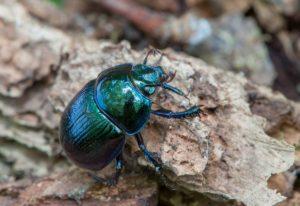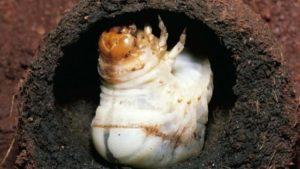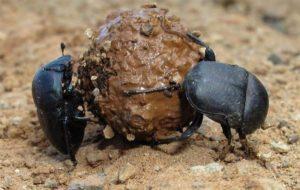Dung beetle that rolls balls - who is this insect
In nature, there are many unusual and unique insects. Each of them has their own role. Dung beetles have always been revered by the ancient Egyptians. There are over 600 varieties of this family.
Content
Dung beetles: photo
Description of the dung beetle
Name: Dung beetle or dung beetle
Latin: GeotrupidaeClass: Insects - Insecta
Squad: Coleoptera - Coleoptera
 | Habitats: | grasslands, fields, prairies, farmland |
 | Dangerous for: | not dangerous |
 | Means of destruction: | traps, rarely used |
The size of the insect varies from 2,7 cm to 7 cm. The body may have an oval or rounded convex shape. At beetle massive pronotum, which is decorated with depressed points.
The color can be yellowish, brown, yellow-brown, red-brown, purple, brown, black. The body has a metallic sheen.
The lower part of the body has a violet-blue hue. Elytra with 14 distinct grooves. There are black hairs on the grooves. The upper jaw is rounded. The forelimbs are shorter than the rest. At the ends of the antennae there is a three-segment club and down.
Life cycle of a dung beetle
Each species has a different oviposition. Some varieties roll balls of manure. This is the place of masonry. The larvae feed on this diet until pupation begins.
Other species equip nests and are engaged in the preparation of manure or humus. Some of the beetles lay right in the manure. Eggs develop within 4 weeks.
The larvae are thick. They have a C-shaped body shape. The color is yellowish or white. The head capsule is dark. The larvae have a powerful jaw apparatus. Formed, the larvae do not excrete feces. The stools accumulate in special bags and a hump forms.
The diet of dung beetles
The diet of an insect can be judged by the name of the species. Beetles feed on humus, fungi, carrion particles, and forest litter. They like any decaying organic matter. Particular preference is given to horse feces. Some varieties can do without food.
Most beetles prefer herbivore dung, which contains semi-digested grass and a smelly liquid.
Dung beetle habitat
Many people think that beetles live only on the African continent. However, it is not. They are found everywhere. It can be Europe, South Asia, America. Habitats:
- farmland;
- the woods;
- meadows;
- prairies;
- semi-deserts;
- desert.
Natural enemies of dung beetles
Beetles are easy to spot. They move slowly and enemies can easily catch them. Many birds and mammals feed on them. Natural enemies include crows, moles, hedgehogs, foxes.
Most of all, beetles are afraid of ticks, which are able to bite through the chitinous cover and suck out blood. One beetle can be attacked by many ticks.
Young and inexperienced animals may try to attack the beetle. In this case, the insects freeze and tighten their legs, pretending to be dead. When bitten, the beetles roll over onto their backs and extend their limbs. In the mouth of a predator, they make grinding sounds with the help of friction of the elytra and abdomen.
Sharp notches on powerful limbs do not allow to eat the beetle. Biting it, the appearance of undigested excrement occurs, which predators cannot tolerate.
Varieties of dung beetles
Benefits of dung beetles
Insects can rightfully be called powerful processors. They dig in manure, loosening and nourishing the soil. Thus, they control the number of flies. Beetles disperse plant seeds. This is an important factor in the ecosystem. The insect regenerates a cut down or burned forest.
Methods of dealing with the dung beetle
Mostly they get rid of beetles because of the fear of insects. This lamellar mustache does not carry harm to people.
Can be used hanging bait:
- This requires a 2 liter bottle.
- The neck of the container is cut off.
- Holes are created around the perimeter to stretch a strong rope on which there will be a trap.
- Manure is laid out at the bottom.
Also a good effect sticky trap. Manure is placed in any vessel with a large diameter. Grease is applied around, to which dung beetles stick.
From folk remedies you can use decoction of onion peel. For cooking:
- Take 1 kg of onion peel and a bucket of water.
- The husk is poured with boiling water.
- Insist 7 days in a closed state.
- Further filter.
- Add more water in a ratio of 1:1.
- Spray the habitats of the dung beetle.
7 interesting facts
During the formation of a ball of manure and transportation, the stars are a guide for insects.
Flights over short distances are possible to find food. Although the bugs themselves are slow pedestrians.
Dung beetles help predict the weather. Large populations are a messenger of calm and clear weather. When the beetles hide in holes, wait for the weather to change.
Onthophagus taurus is the strongest insect. He can carry a load that exceeds the weight of the body by 1141 times.
In fog, the beetles extract moisture, which collects on its head and enters its mouth.
Some species unite in small colonies, build burrows and live as a family. Even males can coexist peacefully.
Both the front and hind limbs are involved in the work. Beetles are equally good at paws, rolling pellets. They can also push while standing on the front legs, rear.
Conclusion
Dung beetles are an important part of the ecosystem. They recycle feces in a variety of ways. Beetles support the litter cycle in nature, but do not turn our planet into a garbage dump.
Previous

